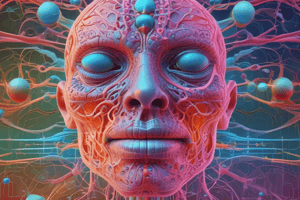Podcast
Questions and Answers
What does homeostasis literally mean?
What does homeostasis literally mean?
Which statement accurately describes homeostasis?
Which statement accurately describes homeostasis?
What is considered the cause of most diseases related to homeostasis?
What is considered the cause of most diseases related to homeostasis?
What happens when the factors in homeostasis remain abnormal?
What happens when the factors in homeostasis remain abnormal?
Signup and view all the answers
In a negative feedback mechanism regulating body temperature, the nerve endings in the skin are considered what?
In a negative feedback mechanism regulating body temperature, the nerve endings in the skin are considered what?
Signup and view all the answers
Which of the following best defines a dynamic equilibrium in the context of homeostasis?
Which of the following best defines a dynamic equilibrium in the context of homeostasis?
Signup and view all the answers
Which mechanism is functioning abnormally during homeostatic imbalance?
Which mechanism is functioning abnormally during homeostatic imbalance?
Signup and view all the answers
What role do nerve endings play in maintaining homeostasis?
What role do nerve endings play in maintaining homeostasis?
Signup and view all the answers
What is the primary role of positive feedback compared to negative feedback?
What is the primary role of positive feedback compared to negative feedback?
Signup and view all the answers
Which system is responsible for delivering oxygen and nutrients throughout the body?
Which system is responsible for delivering oxygen and nutrients throughout the body?
Signup and view all the answers
What function does the lymphatic system primarily serve?
What function does the lymphatic system primarily serve?
Signup and view all the answers
How does negative feedback contribute to homeostasis in the body?
How does negative feedback contribute to homeostasis in the body?
Signup and view all the answers
What is the main role of the immune system?
What is the main role of the immune system?
Signup and view all the answers
What does the urinary system primarily help to manage?
What does the urinary system primarily help to manage?
Signup and view all the answers
Which feedback mechanism is considered critical to health?
Which feedback mechanism is considered critical to health?
Signup and view all the answers
Which of these systems is NOT involved in immune response?
Which of these systems is NOT involved in immune response?
Signup and view all the answers
Which body cavities contain the lungs?
Which body cavities contain the lungs?
Signup and view all the answers
What structures are organized within the dorsal body cavity?
What structures are organized within the dorsal body cavity?
Signup and view all the answers
Which cavity houses the spinal cord?
Which cavity houses the spinal cord?
Signup and view all the answers
Which of the following is NOT part of the thoracic cavity?
Which of the following is NOT part of the thoracic cavity?
Signup and view all the answers
The lungs are nested within which of these cavities?
The lungs are nested within which of these cavities?
Signup and view all the answers
Which of the following correctly describes the relationship between the thoracic cavity and the ventral cavity?
Which of the following correctly describes the relationship between the thoracic cavity and the ventral cavity?
Signup and view all the answers
Which body cavity encases the heart?
Which body cavity encases the heart?
Signup and view all the answers
Which statement is incorrect regarding the spinal cord's location?
Which statement is incorrect regarding the spinal cord's location?
Signup and view all the answers
Which organ system is closely associated with the lymphatic system?
Which organ system is closely associated with the lymphatic system?
Signup and view all the answers
Which statement accurately reflects how organ systems operate?
Which statement accurately reflects how organ systems operate?
Signup and view all the answers
Which of the following best describes the endocrine system's structural classification?
Which of the following best describes the endocrine system's structural classification?
Signup and view all the answers
Which two organ systems work together to supply oxygen to the blood and remove carbon dioxide?
Which two organ systems work together to supply oxygen to the blood and remove carbon dioxide?
Signup and view all the answers
What components can organ systems be composed of?
What components can organ systems be composed of?
Signup and view all the answers
Which organ system is NOT primarily involved in immune response?
Which organ system is NOT primarily involved in immune response?
Signup and view all the answers
Which system is mainly responsible for transporting nutrients throughout the body?
Which system is mainly responsible for transporting nutrients throughout the body?
Signup and view all the answers
The removal of carbon dioxide from the blood primarily occurs in which organ system?
The removal of carbon dioxide from the blood primarily occurs in which organ system?
Signup and view all the answers
What is the primary role of platelets when bleeding occurs?
What is the primary role of platelets when bleeding occurs?
Signup and view all the answers
In which scenario does negative feedback occur?
In which scenario does negative feedback occur?
Signup and view all the answers
What distinguishes positive feedback mechanisms from negative feedback mechanisms?
What distinguishes positive feedback mechanisms from negative feedback mechanisms?
Signup and view all the answers
How does the body respond to increased temperature in a negative feedback manner?
How does the body respond to increased temperature in a negative feedback manner?
Signup and view all the answers
Which statement best describes a positive feedback system?
Which statement best describes a positive feedback system?
Signup and view all the answers
What initiates and maintains prolactin production during breastfeeding?
What initiates and maintains prolactin production during breastfeeding?
Signup and view all the answers
Why are positive feedback mechanisms considered to occur for non-routine events?
Why are positive feedback mechanisms considered to occur for non-routine events?
Signup and view all the answers
What is one consequence of the clustering and signaling of platelets at a wound site?
What is one consequence of the clustering and signaling of platelets at a wound site?
Signup and view all the answers
Study Notes
Homeostasis
- Homeostasis refers to the body's ability to maintain a stable internal environment despite external changes.
- Factors such as blood pressure, blood glucose concentration, and body temperature must remain within specific normal ranges for optimal functioning.
- Abnormal levels in these factors can lead to illness or death, emphasizing the importance of homeostasis.
Dynamic Equilibrium
- Homeostasis is often described as a dynamic equilibrium, signifying continuous adjustments and processes to maintain stability.
- The body consistently works to keep various physiological parameters within their normal ranges, responding dynamically to changes.
Homeostatic Imbalance
- Homeostatic imbalance is a leading cause of many diseases.
- It represents a failure of the body to maintain stable internal conditions, leading to potential health crises.
Feedback Mechanisms
- Negative Feedback Mechanisms: These mechanisms reduce the initial stimulus, such as sweating to cool down the body temperature, thereby promoting homeostasis.
- Positive Feedback Mechanisms: These amplify the initial stimulus, such as platelets accumulating at a wound site to address bleeding, resulting in a cascade effect. This type is typically engaged in sporadic events.
Comparison of Feedback Mechanisms
- Positive feedback enhances the triggering stimulus, while negative feedback works to return to homeostatic balance or an ideal state.
- Positive feedback mechanisms are critical for specific events (e.g., childbirth, blood clotting), while negative feedback mechanisms are routine and help in daily bodily functions.
Organ Systems and Functions
- Endocrine System: Regulates body functions through hormones.
- Cardiovascular System: Delivers oxygen and nutrients to tissues while removing waste products like carbon dioxide.
- Immune System: Produces antibodies to combat foreign substances.
- Lymphatic System: Filters excess fluid from tissues and produces lymphocytes for immune responses.
- Urinary System: Maintains electrolyte balance, blood pH, and removes toxins from the blood.
Overlap in Organ System Functions
- The cardiovascular and respiratory systems collaborate to supply oxygen to blood and expel carbon dioxide, highlighting the interconnectedness of organ systems.
Body Cavities
- The pleural cavity encloses the lungs, situated within the thoracic cavity, which in turn is part of the larger ventral cavity.
- The dorsal cavity protects the nervous system, comprising the cranial cavity (for the brain) and vertebral cavity (for the spinal cord).
Studying That Suits You
Use AI to generate personalized quizzes and flashcards to suit your learning preferences.
Description
This quiz explores the concept of homeostasis and its critical role in maintaining a stable internal environment. You'll learn about dynamic equilibrium, homeostatic imbalance, and the feedback mechanisms involved in physiological regulation. Test your understanding of how the body manages various factors to ensure optimal functioning.




